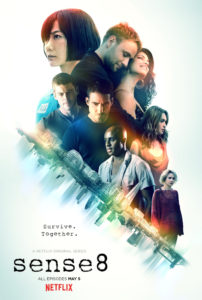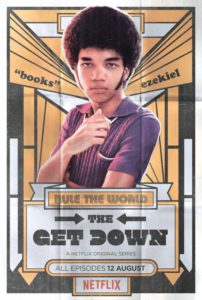
 June first is a day of many things – rent for many is due, some folks wake up saying “rabbit, rabbit” as their first words for good luck – but for any LGBTQ person it’s an important day. It’s the first day of Pride Month.
June first is a day of many things – rent for many is due, some folks wake up saying “rabbit, rabbit” as their first words for good luck – but for any LGBTQ person it’s an important day. It’s the first day of Pride Month.
Which means that countless businesses roll out rainbow-colored marketing apparatuses: Google’s doodle, Oreo’s rainbow-stuffed cookie, Target’s entire line of Pride regalia. Netflix, however, seemed to miss the memo: Netflix announced that they were, in fact, cancelling Sense8.
The news of Sense8’s cancellation gutted me. Sense8’s characters were not – could not ever be, considering that the core eight were one person and eight at the same time – straight or cisgender. Because Will was Lito and Lito was Will, because Naomi was Sun and Sun was Naomi. The show opened with Naomi – a trans woman – having sex with her longtime partner, Amanita. One of season two’s highest of highs is Lito coming out to the world at Pride in Sao Paulo. The show was always been centered on telling the stories of LGBTQ people.
Happy Pride.
But Sense8 didn’t just tell the stories of LGBTQ people – it told complex, global stories. The show was, frankly, massive. Capheus’ scenes were shot in Kenya, Sun’s in Korea, Lito’s in Mexico (except when he travelled), Riley’s – and later Will’s – scenes took us all over Europe, Wolfgang in Berlin, Naomi in San Francisco, and Kala in India.
Sense8 was global – and not just in location. Naomi was played by Jamie Clayton, a trans woman in a trans role, Miguel Ángel Silvestre is not just a man who learned to speak Spanish for the role, he’s a native speaker. The Wachowskis dealt with great criticism for putting white actors in yellowface in Cloud Atlas. The lessons appear to be learned in Sense8’s wide range of actors and characters. And while Sense8’s attempts at globalization weren’t perfect and often relied heavily on stereotypes of places like Kenya or Mumbai as a crutch – Sense8, to this writer, was a far greater attempt towards what television should look like in 2017. Not perfect, but moving closer towards.
 Which is why Netflix’s The Get Down seemed like a natural progression from Sense8’s production and release. The Get Down focused entirely on stories of people of color, as it told a Baz Luhrmann stylized tale of the creation of hip-hop in the South Bronx during the turbulent late 1970s.
Which is why Netflix’s The Get Down seemed like a natural progression from Sense8’s production and release. The Get Down focused entirely on stories of people of color, as it told a Baz Luhrmann stylized tale of the creation of hip-hop in the South Bronx during the turbulent late 1970s.
The Get Down’s stunning visuals, sharp soundtrack and tenderly-wrought characters told a story that is so, so needed in 2017: stories about smart, driven, and talented black and latino teenagers. The Get Down offered us complex portrayals of gender and sexuality as Dizzie and Thor came together, as Mylene’s first single became a hit on the New York ball scene.
The Get Down was cancelled days before Sense8 got the axe.
These cancellations were explained by CEO Reed Hastings as this: “We have to take more risk; you have to try more crazy things. Because we should have a higher cancel rate overall.”
13 Reasons Why, the adaptation of the book by Jay Asher, has been greenlit for a second season. The show has received criticism from suicide prevention experts for doing all of the wrong things to prevent teen suicide and furthermore: the story is over. All thirteen of Hannah’s suicide tapes have been heard, Clay has “learned” from Hannah’s death, the story is over.
What more can be expanded upon in the universe of 13 Reasons Why? Do they plan to move it to a teen drama (and thus make its name entirely confusing and inappropriate)? Will there be a copycat suicide (and thus will it become a murder mystery)?
Meanwhile, in The Get Down’s second season: do Thor and Dizzie stay together? What happens to the Fantastic Four Plus One? Do Mylene and Zeke make it? Do Shao and Zeke ever finally kiss? How does the transition from the unrest of the 70s in the 80s treat our characters? Will we see the impact of the crack epidemic on the Fantastic Four Plus One? What about the AIDS crisis? What does the future (our history) look like for these characters?
In the third season of Sense8: Is Wolfgang okay? Does the cluster ever escape the clutches of B.P.O.? Do Sun and Will tear the entire organization down brick by brick for hurting their cluster? DO KALA AND WOLFGANG GO TO PARIS?
But these questions will not be answered. At least, not the ones that seem to take more risk.
Because Netflix is choosing “safe” shows, ones that focus on the stories of – predominantly – white, cis, and straight casts of 13 Reasons Why and Iron Fist.
Sense8’s global story is bold, completely unparalleled in scale. Watching the cast of eight film all on-location is staggering to watch, as bodies shift and fly in and out of frame to create the gorgeous “sharing” sequences.
The Get Down’s highly stylized storytelling is traditional of Luhrmann, but not on this level. Luhrmann’s body of work has dealt with highly classical forms of theatrics. The Get Down blends Luhrmann’s penchant for theater and drama with depictions of institutionalized racism, violence, and economic injustice.
It’s easy, even if you just watched the pilots of the three, to tell which shows do what Hastings claims to want Netflix’s programing to be.
Hasting’s definition of “risk” certainly looks a lot whiter than mine does. If you need me, I’ll be in the corner, wearing my RENEW DEAR WHITE PEOPLE hat, t-shirt, and shorts. It’s the last piece of truly striking, thought-provoking, and interesting show Netflix has that features people of color and a gay main character.



![[PODCAST] THE COMICS AGENDA: THE UNSTOPPABLE JUGGERNAUT HAS COME TO TOWN.](https://geekd-out.com/wp-content/uploads/2017/11/comics-agenda-2-150x150.jpg)